Snowflake Bundle
How Did Snowflake Become a Data Cloud Giant?
Snowflake, a leading cloud-based data platform, burst onto the scene in 2012 with a revolutionary vision for data management. Its inception marked a pivotal moment in the industry, offering a cloud-native solution designed to overcome the limitations of older data platforms. By separating compute from storage, Snowflake unlocked unprecedented scalability and flexibility, allowing businesses to optimize both cost and performance.
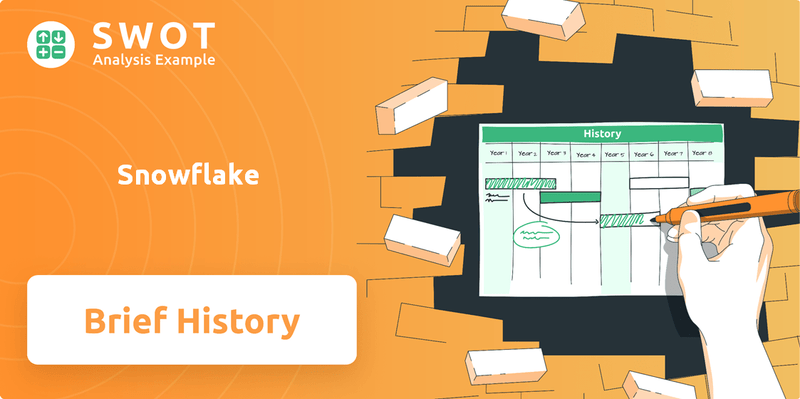
From its humble beginnings in San Mateo, California, the Snowflake SWOT Analysis reveals a company that prioritized building a data warehouse specifically for the cloud, making data analytics accessible to all. This innovative approach has fueled Snowflake's incredible growth, with a significant customer base and substantial revenue, showcasing its impact on cloud data warehousing. This exploration of the Snowflake history will delve into the key milestones, innovations, and challenges that have shaped its trajectory in the data analytics landscape, providing a comprehensive understanding of the Snowflake company origin and its evolution.
What is the Snowflake Founding Story?
The Revenue Streams & Business Model of Snowflake is a fascinating story of innovation in cloud data warehousing. Snowflake Inc. began its journey on July 23, 2012, in San Mateo, California. The company's founders, Benoît Dageville, Thierry Cruanes, and Marcin Żukowski, saw a need for a more flexible and scalable data solution.
Their vision was to create a data warehouse specifically designed for the cloud. This would allow for dynamic scaling and efficient data storage and analytics. The founders, with backgrounds at Oracle Corporation and Vectorwise, brought a wealth of experience to the table. This led to the creation of the Snowflake platform.
Snowflake's initial focus was on building a cloud-native data warehouse. This was a key element of its early strategy. This approach aimed to make data analytics accessible to companies of all sizes by removing the need for complex hardware or software configurations. The company's early success was fueled by its innovative approach to cloud data warehousing.
Snowflake's founding team included Benoît Dageville, Thierry Cruanes, and Marcin Żukowski. They aimed to address the limitations of existing data warehousing solutions. The company operated in stealth mode for two years, focusing on product development.
- Snowflake was founded on July 23, 2012.
- Early funding came from Sutter Hill Ventures, with a $5 million Series A round in August 2012.
- Mike Speiser served as the first CEO from August 2012 to June 2014.
- The name 'Snowflake' was chosen in honor of the founders' love for snow sports.
Snowflake's initial business model was consumption-based. Customers paid based on their usage of compute and storage. This model offered greater flexibility than traditional subscription models. This approach was designed to make data analytics more accessible.
- The consumption-based pricing model was a key differentiator.
- It aimed to remove barriers to entry for companies of all sizes.
- The focus was on providing dynamic and scalable data storage and analytics.
- The company's early strategy was centered on cloud data warehousing.
Snowflake SWOT Analysis
- Complete SWOT Breakdown
- Fully Customizable
- Editable in Excel & Word
- Professional Formatting
- Investor-Ready Format
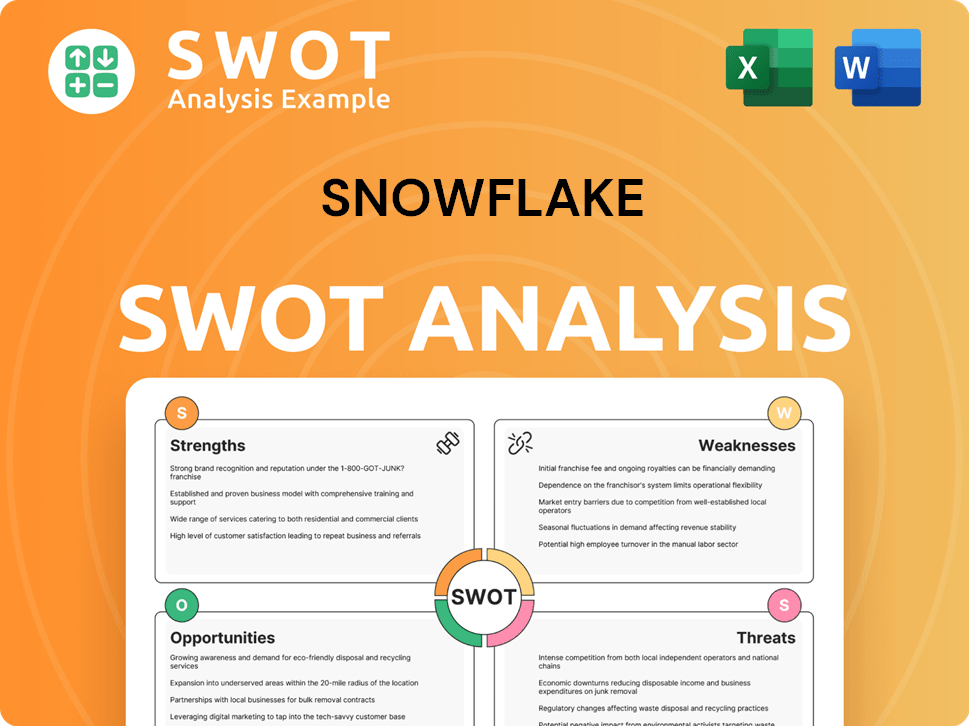
What Drove the Early Growth of Snowflake?
The early years of the Snowflake company were marked by rapid expansion and strategic developments. Officially emerging from stealth mode in October 2014, the Snowflake data warehouse already had a base of approximately 80 organizations using its platform. This period was characterized by significant capital raises and pivotal leadership changes that fueled its growth.
In June 2015, the company launched its first product, a cloud data warehouse, marking a key milestone in its history. This launch solidified its position in the cloud data warehousing market. The introduction of its core product was a defining moment for the Snowflake platform.
Snowflake secured substantial funding during its early growth phase. In October 2014, it raised $26 million, followed by $45 million in June 2015. These financial infusions were crucial for supporting product development and market expansion.
Bob Muglia, formerly of Microsoft, became CEO in June 2014, playing a critical role in accelerating Snowflake's growth. Under Muglia's leadership, the company secured hundreds of millions in funding. This leadership transition was a key factor in shaping the company's trajectory.
Snowflake expanded its cloud infrastructure support, initially running on Amazon Web Services (AWS) from 2014. It later added Microsoft Azure in 2018 and Google Cloud Platform (GCP) in 2019. This multi-cloud strategy significantly broadened its market reach, offering flexibility to its users.
Snowflake PESTLE Analysis
- Covers All 6 PESTLE Categories
- No Research Needed – Save Hours of Work
- Built by Experts, Trusted by Consultants
- Instant Download, Ready to Use
- 100% Editable, Fully Customizable
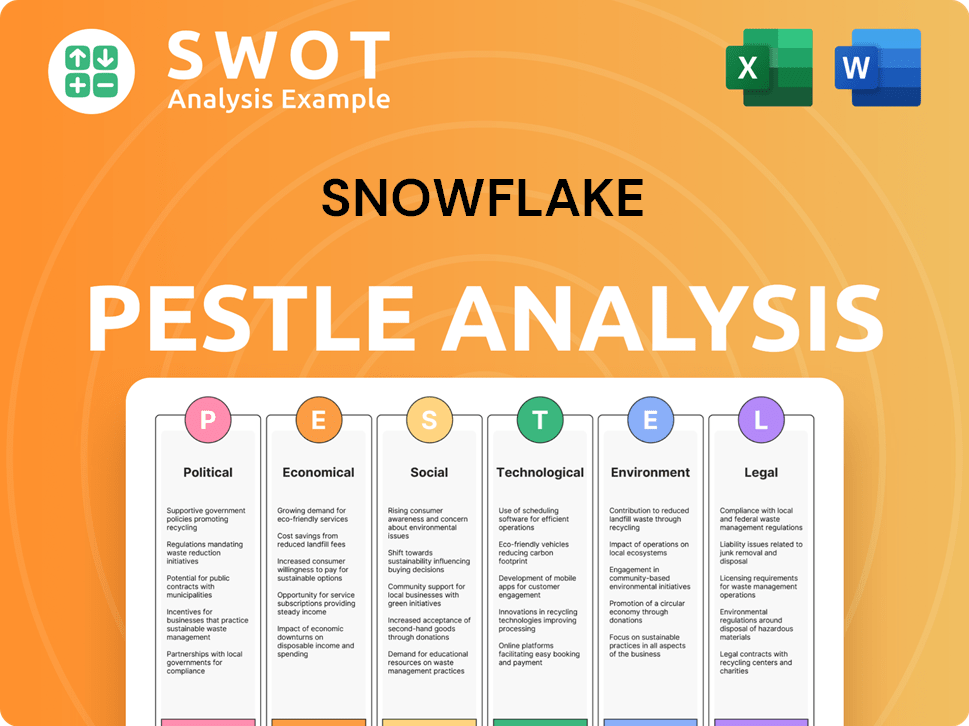
What are the key Milestones in Snowflake history?
The Snowflake company has achieved significant milestones, including a record-breaking initial public offering (IPO) and the continuous expansion of its cloud data warehousing capabilities. These achievements highlight its rapid growth and influence in the data analytics sector.
| Year | Milestone |
|---|---|
| 2020 | Completed its IPO on September 16, raising $3.4 billion, with shares opening at $245 each. |
| 2021 | Introduced Unistore, combining transactional and analytical operations on a single platform. |
| 2023 | Launched the Native App Framework, enabling developers to build and monetize applications within the Snowflake platform. |
| 2024 | Launched Cortex, a suite of generative AI services integrated into the platform. |
| 2025 | Acquired Crunchy Data to bolster its PostgreSQL services and AI Data Cloud. |
Product innovation has been central to the
Introduced in 2020, Snowpark allows users to write data pipelines and business logic directly within Snowflake using languages like Java, Scala, and Python.
Launched in 2021, Unistore merges transactional and analytical operations, streamlining data management on a single platform.
Released in 2023, this framework enables developers to create and monetize applications directly within the Snowflake environment.
Launched in 2024, Cortex provides generative AI services, including access to large language models and vector search, to build AI-powered applications.
Acquired Neeva for $185 million in May 2023 to enhance its search capabilities and improve user experience within the Snowflake platform.
Announced in June 2025, the acquisition of Crunchy Data for approximately $250 million aims to strengthen PostgreSQL services and the AI Data Cloud.
Despite its successes, the
Intense competition from major tech companies such as Amazon (Redshift), Google (BigQuery), and Microsoft (Azure Synapse) poses a significant challenge.
The company reported a net loss of $1.29 billion for the fiscal year ending January 31, 2025, reflecting investments in sales, marketing, and R&D.
Snowflake continuously refines its offerings and focuses on strategic partnerships and acquisitions to meet market demands and competitive pressures.
The cloud data warehousing market is rapidly evolving, requiring Snowflake to adapt quickly to changing technologies and customer needs.
Significant investments in research and development, particularly in AI, are crucial for maintaining a competitive edge and driving future growth.
Focusing on customer acquisition and retention is essential, requiring effective sales strategies and competitive pricing within the cloud computing landscape.
Snowflake Business Model Canvas
- Complete 9-Block Business Model Canvas
- Effortlessly Communicate Your Business Strategy
- Investor-Ready BMC Format
- 100% Editable and Customizable
- Clear and Structured Layout
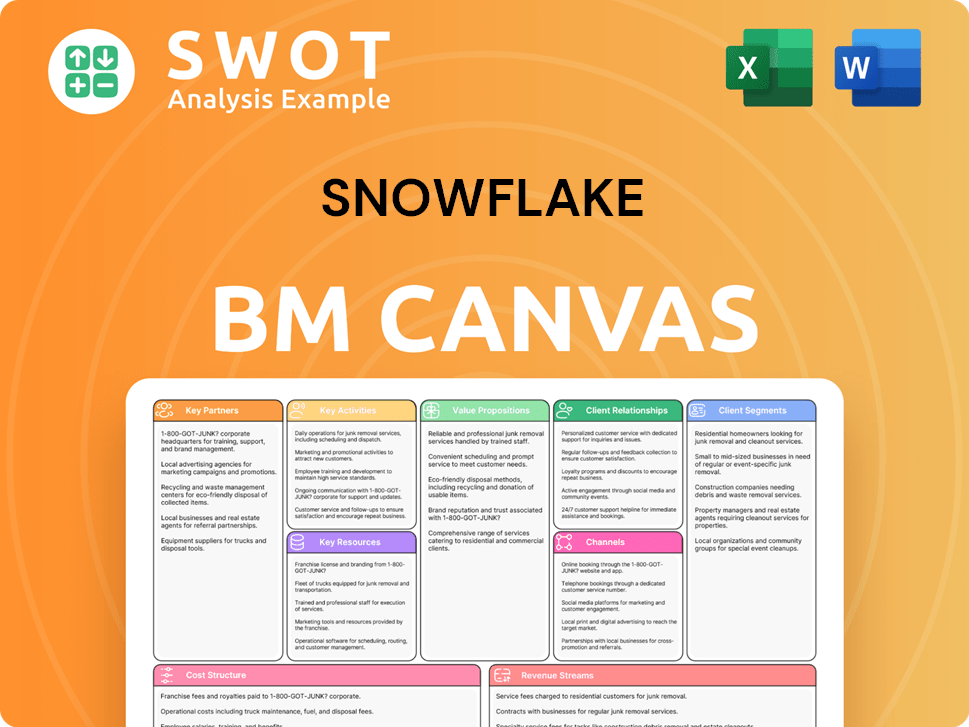
What is the Timeline of Key Events for Snowflake?
The journey of the Snowflake company began in July 2012 in San Mateo, California. The company quickly secured its initial funding and emerged from stealth mode in October 2014. The company launched its cloud data warehouse product in June 2015 and achieved unicorn status in January 2018. Following several funding rounds and the appointment of Frank Slootman as CEO in May 2019, the company went public on September 16, 2020. The company has continued to evolve, including strategic acquisitions and the launch of new services like Cortex in 2024, and a change in leadership with Sridhar Ramaswamy succeeding Frank Slootman as CEO in February 2024.
| Year | Key Event |
|---|---|
| July 2012 | Snowflake Inc. was founded in San Mateo, California. |
| August 2012 | Raised $5 million in Series A funding led by Sutter Hill Ventures. |
| October 2014 | Emerged from stealth mode and raised $26 million. |
| June 2015 | Launched its first cloud data warehouse product. |
| April 2017 | Raised $100 million in funding. |
| January 2018 | Achieved unicorn status with a $263 million funding round at a $1.5 billion valuation. |
| October 2018 | Raised $450 million in a round led by Sequoia Capital, valuing the company at $3.5 billion. |
| May 2019 | Frank Slootman joins as CEO. |
| February 2020 | Raised $479 million in Series G funding. |
| September 16, 2020 | Became a public company via IPO, raising $3.4 billion. |
| May 2021 | Becomes a distributed company with its principal executive office in Bozeman, Montana. |
| October 2022 | Acquired a 5% stake in OpenAP. |
| May 2023 | Acquired Neeva for $185 million. |
| February 28, 2024 | Frank Slootman retires as CEO, succeeded by Sridhar Ramaswamy. |
| 2024 | Launched Cortex, a set of generative AI services. |
| June 2025 | Announces acquisition of Crunchy Data for approximately $250 million. |
Snowflake is expected to continue significant growth, driven by its focus on the AI Data Cloud and expanding market opportunities. Analysts anticipate sustained 20%+ top-line growth over the long term.
For fiscal year 2025, Snowflake reported revenue of $3.63 billion, a 29% increase from 2024. The company anticipates product revenue to reach approximately $4.28 billion for fiscal year 2026.
The total addressable market (TAM) for Snowflake is projected to reach $342 billion by 2028. This growth is largely due to the introduction of new products and workflows, especially in AI.
The company plans to continue strategic acquisitions and investments to enhance its platform capabilities. Key initiatives include leveraging its strong cash position and emphasizing network effects to enhance data collaboration within the Snowflake ecosystem.
Snowflake Porter's Five Forces Analysis
- Covers All 5 Competitive Forces in Detail
- Structured for Consultants, Students, and Founders
- 100% Editable in Microsoft Word & Excel
- Instant Digital Download – Use Immediately
- Compatible with Mac & PC – Fully Unlocked
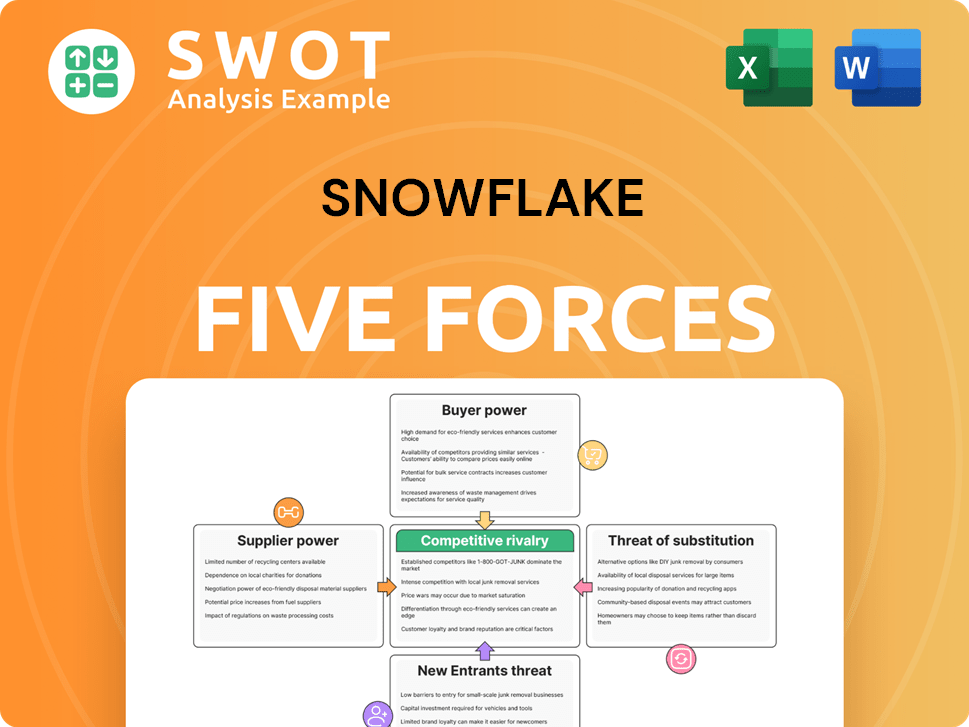
Related Blogs
- What is Competitive Landscape of Snowflake Company?
- What is Growth Strategy and Future Prospects of Snowflake Company?
- How Does Snowflake Company Work?
- What is Sales and Marketing Strategy of Snowflake Company?
- What is Brief History of Snowflake Company?
- Who Owns Snowflake Company?
- What is Customer Demographics and Target Market of Snowflake Company?
Disclaimer
All information, articles, and product details provided on this website are for general informational and educational purposes only. We do not claim any ownership over, nor do we intend to infringe upon, any trademarks, copyrights, logos, brand names, or other intellectual property mentioned or depicted on this site. Such intellectual property remains the property of its respective owners, and any references here are made solely for identification or informational purposes, without implying any affiliation, endorsement, or partnership.
We make no representations or warranties, express or implied, regarding the accuracy, completeness, or suitability of any content or products presented. Nothing on this website should be construed as legal, tax, investment, financial, medical, or other professional advice. In addition, no part of this site—including articles or product references—constitutes a solicitation, recommendation, endorsement, advertisement, or offer to buy or sell any securities, franchises, or other financial instruments, particularly in jurisdictions where such activity would be unlawful.
All content is of a general nature and may not address the specific circumstances of any individual or entity. It is not a substitute for professional advice or services. Any actions you take based on the information provided here are strictly at your own risk. You accept full responsibility for any decisions or outcomes arising from your use of this website and agree to release us from any liability in connection with your use of, or reliance upon, the content or products found herein.